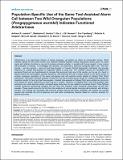Population-specific use of the same tool-assisted alarm call between two wild orangutan populations (Pongopygmaeus wurmbii) indicates functional arbitrariness
Abstract
Arbitrariness is an elementary feature of human language, yet seldom an object of comparative inquiry. While arbitrary signals for the same function are relatively frequent between animal populations across taxa, the same signal with arbitrary functions is rare and it remains unknown whether, in parallel with human speech, it may involve call production in animals. To investigate this question, we examined a particular orangutan alarm call - the kiss-squeak - and two variants - hand and leaf kiss-squeaks. In Tuanan (Central Kalimantan, Indonesia), the acoustic frequency of unaided kiss-squeaks is negatively related to body size. The modified variants are correlated with perceived threat and are hypothesized to increase the perceived body size of the sender, as the use of a hand or leaves lowers the kiss-squeak's acoustic frequency. We examined the use of these variants in the same context in another orangutan population of the same sub-species and with partially similar habitat at Cabang Panti (West Kalimantan, Indonesia). Identical analyses of data from this site provided similar results for unaided kiss-squeaks but dissimilar results for hand and leaf kiss-squeaks. Unaided kiss-squeaks at Cabang Panti were emitted as commonly and showed the same relationship to body size as in Tuanan. However, at Cabang Panti, hand kiss-squeaks were extremely rare, while leaf-use neither conveyed larger body size nor was related to perceived threat. These findings indicate functional discontinuity between the two sites and therefore imply functional arbitrariness of leaf kiss-squeaks. These results show for the first time the existence of animal signals involving call production with arbitrary function. Our findings are consistent with previous studies arguing that these orangutan call variants are socially learned and reconcile the role of gestures and calls within evolutionary theories based on common ancestry for speech and music.
Citation
Lameira , A R , Hardus , M E , Nouwen , K J J M , Topelberg , E , Delgado , R A , Spruijt , B M , Sterck , E H M , Knott , C D & Wich , S A 2013 , ' Population-specific use of the same tool-assisted alarm call between two wild orangutan populations ( Pongopygmaeus wurmbii ) indicates functional arbitrariness ' , PLoS ONE , vol. 8 , no. 7 , e69749 . https://doi.org/10.1371/journal.pone.0069749
Publication
PLoS ONE
Status
Peer reviewed
ISSN
1932-6203Type
Journal article
Description
This study was financially supported by Fundação para a Ciência e Tecnologia (SFRH/BD/44437/2008), Wenner-Gren Foundation for Anthropological Research, Dr. J.L. Dobberke voor Vergelijkende Psychologie, Lucie Burgers Foundation for Comparative Behaviour Research, Schure-Beijerinck-Popping Fonds, Ruggles-Gates Fund for Anthropological Scholarship of the Royal Anthropological Institute of Great Britain and Ireland, and Fundação Calouste Gulbenkian. KN and ET were financially supported by Pongo Foundation. Orangutan fieldwork at Cabang Panti was supported by grants to CDK from the 16 National Science Foundation (0936199), the National Geographic Society, the Leakey Foundation and the US Fish and Wildlife Service.Collections
Items in the St Andrews Research Repository are protected by copyright, with all rights reserved, unless otherwise indicated.

